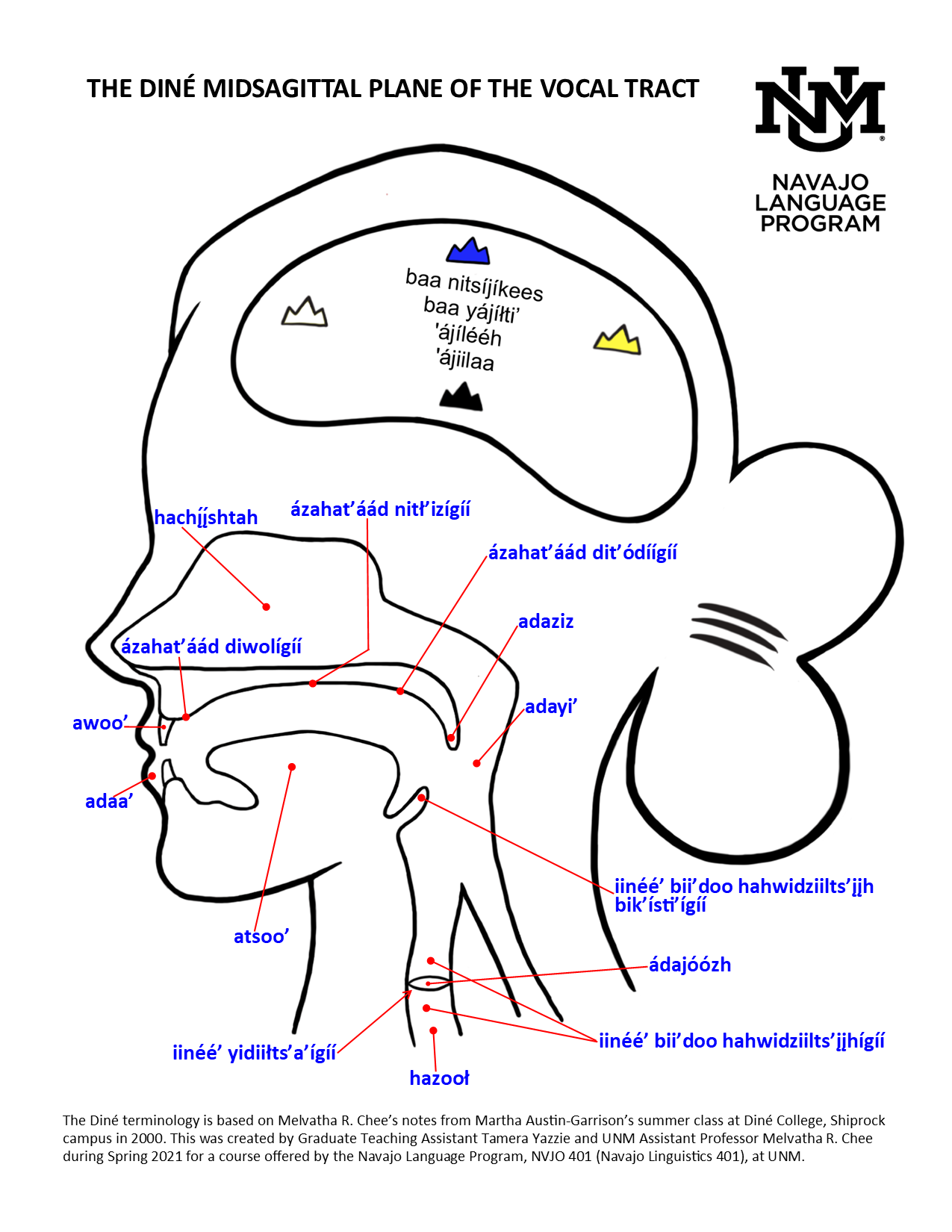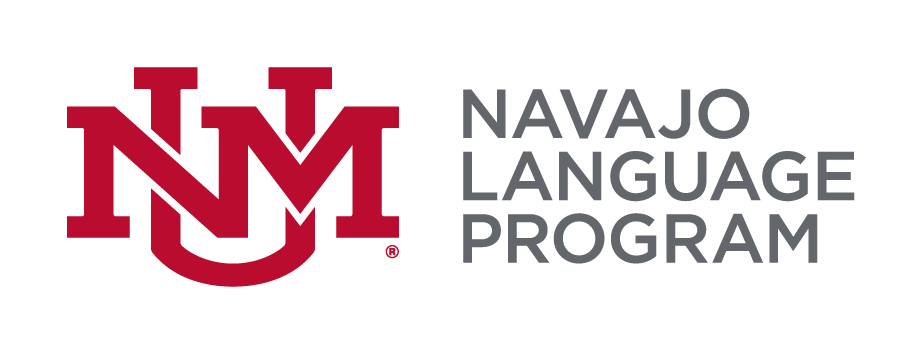Navajo Sound Profile
The Navajo Sound Profile project provides a detailed description of the sounds of the Navajo language as spoken by the Diné people today in order to provide an important resource to the Navajo community, and as a contribution to our understanding of the language. This kind of systematic documentation of the spoken language, while common for more studied languages, is rare for indigenous communities worldwide. The Navajo Sound Profile represents the sound phoneme inventory as it is spoken across Navajo land. We hope to extend the project by adding examples of speech from different areas of the Navajo Nation both to enhance the documentation of the Navajo language and to document linguistic variation and change. This project is intended to support Navajo language students, linguists, and community members into the future.
Navajo or Diné Bizaad (ISO: nav) is a member of the Apachean branch of the Dene (Athabaskan) language family. The Dene languages are spoken throughout the whole of western North America and are closely related despite this extraordinary spread. Diné Bizaad is spoken on Diné Bikéyah (https://navajofamilies.org/navajo.html) in Arizona, New Mexico, and the Four Corners area of Utah. As a result of the 1950 Indian Relocation Program and in search of economic stability, many Diné now live in urban areas throughout the United States. The Diné Nation with a population of 399,494 (https://en.wikipedia.org/wiki/Navajo) is the largest area retained as a sovereign nation by Indigenous peoples in the United States.
An overriding goal of this project is to build support for reversing the shift to English by Navajo speakers, by building tools and materials that will enable Navajo language use and learning. By providing sound samples, visuals, and explanations of Diné centric sound system, we hope that our students may use this work to support their efforts in learning to speak Diné Bizaad.
The spread of English among Diné speaking children was recognized in 1973 by Dr. Bernard Spolsky (1974). Since then, reports from the U.S Census have steadily shared reports showing a downward trend of Diné speakers. According to the U.S. Census, over 90% of the Navajo population spoke Diné Bizaad. The 1990 report stated that over 85% spoke Diné Bizaad. The 2000 report showed that over 77% of Navajos spoke Diné Bizaad, while Ichihashi-Nakayama et al (2007) estimated about 72% of tribal members spoke Diné. The 2010 U.S. Census reported an estimated 50% of the Diné spoke their language. While Ethnologue reports an estimated 156K Navajo speakers, a recent study of language acquisition on the Diné Nation supports a low number of speakers and questions the sustainability of Diné Bizaad (Chee 2017). While visiting numerous communities, Chee (2017) found that most fluent speakers are older than 40, with very few monolingual speakers and very little Diné is being learned in homes as a first language. Navajo is taught in school across the Navajo Nation, with one immersion school in Arizona, and English is used to educate Navajo children. The Navajo language is on track to becoming moribund, although a system of colleges on the Diné Nation (Diné College system in Tsaile, Shiprock and Navajo Technical University, Crownpoint) and at the University of New Mexico, Albuquerque, have programs on Navajo language and culture. Our goal is to change this trajectory of Diné Bizaad and to maintain linguistic diversity.
The Diné themselves recognize dialect differences across the Nation, yet these differences are not documented or well discussed in the literature on the language. Navajo people, among themselves, discuss the differences in their speech and terminology. For example, the typical word for ‘pants’ is tł’aajį’ éé’ while another part of the Navajo Nation uses the term jégi éé’. There may be word differences, but the sound of Diné Bizaad are maintained.
This study focuses on the Eastern Agency of the Diné Nation. It analyzes the speech of the Navajo speaking individual leading this project, adding to a previous study on the phonetics of Diné from speakers in the Eastern Agency (McDonough and Ladefoged 1993; McDonough 2003, McDonough and Wood 2008, Iskarous et al 2012, McDonough 2018) by building on material, recordings and field notes of previous research on the phonetics of Navajo from other Western Agency speakers (McDonough & Austin, 1994). Young and Morgan’s extensive grammars and dictionaries serves as the primary reference for this project.
The Navajo IPA chart that is provided as part of this work incorporate Diné terms, found in Becenti and Chee (1974). Additional terms have been translated in recent years by Begay and Chee (2008 PowerPoint Presentation at Manshantucket Pequot Tribal Nation Conference on Reclamation of Indigenous Languages), and most recently by Chee for use in the Navajo linguistic class at UNM. Melvatha Chee and Tamera Yazzie created the Navajo IPA chart below. The Navajo Midsagittal Face is the result of collaborative by Melvatha Chee and Tamera Yazzie. Melvatha, as a student at Diné College, Shiprock Campus, under the instruction of Martha Austin-Garrison, had notes from one of the courses she took. The terminology used in the midsagittal face were created by Martha Austin-Garrison and any missing terminology was coined by Melvatha Chee. Concepts from Diné thought and songs are incorporated into the Navajo midsagittal face to reflect our representation in this field and to promote the inclusion of the Diné way of knowing.
The Diné orthography is the standard orthography use by the Diné, which is also found in Young and Morgan (1987). This page provides a list of consonantal contrasts of Diné Bizaad, a consonantal inventory similar to those found across the Dene language family. There are 32 consonant phonemes with a contrast at five places of articulation: labial, alveolar, palato-alveolar, velar and glottal.
Navajo has a phonemic four vowel system /i, e, a, o/ with additional contrasts in length, tone and nasality. These four vowels provide a possible thirty-two phonemic vowel contrasts. In Diné orthography, nasality is marked with a hook (ą- /ã/, ąą- /ãː/), high tone is marked with an acute accent (á- /á/, áá- /áː/, ą́- /ã́/, ą́ą́- /ã́ː/), and low tone is unmarked (a- /a/, aa- /aː/). Long vowels are represented by a set of similar vowels (aa- /aː/) and a short vowel is represented by a single vowel (a- /a/). Phonologically speaking, Diné has a five-vowel asymmetric system /I, ii, e, a, o/ (Hojer & Sapir 1945: 26-28; McDonough, 2003).
This project was accomplished through dedication, collaboration, patience, cooperation, and an understanding that this work will benefit the community. We thank Tamera Yazzie, and Geunho Cho for their diligent work in preparing and completing this project. We thank Joyce McDonough for providing guidance, advisement, and in preparing the team in better understanding the phenomena of Navajo phonetics. We thank Melvatha Chee for leading the project and in providing a vision to serve the Navajo community.
References:
Becenti, L. J. & Delphine Chee. 1974. Diné bizaad dadiits’a’ígíí naaskaah [The study of Navajo sounds]. Diné Bizaad Náníl’įįh/Navajo Language Review 1, 39-51.
Begay, J. & Melvatha Chee. 2008, February 21. Navajo Grammar Taught for and by Navajo Speakers. Presented at the 4th Biennial Conference on the Reclamation of Indigenous Languages, Manshantucket, CT. Retrieved on May 20, 2021 from https://osf.io/dra62/.
Chee, M. R. 2017. A longitudinal cross-sectional study on the acquisition of Navajo verbs in children aged 4 years 7 months through 11 years 2 months. Ph.D. dissertation, University of New Mexico, Albuquerque.
Chee, M. R., Yazzie, T., 2021, May 8. Navajo Linguistics, NLP. Retrieved from osf.io/hykaw
Hoijer, H. & Edward Sapir. 1945. Navaho phonology. Albuquerque: The University of New Mexico Press.
Ichihashi-Nakayama, K., Yumitani, Y., & Akira Y. Yamamoto. 2007. Languages of the Southwest United States. The vanishing Languages of the Pacific Rim, edited by Osahito Miyaoka, Osamu Sakiyama, and Michael Krauss. Oxford University Press, pp. 460-474.
Iskarous, K. R., McDonough, J., & Douglas H. Whalen. 2012. A gestural account of the velar fricative in Navajo. Laboratory Phonology, 3, 1, 195-210.
McDonough J. 2010. The Dene Speech Atlas. Online, June 2013, http://www.ling.rochester.edu/DeneSpeechAtlas/
McDonough, J. 2003. The Navajo Sound System. Kluwer Academic Press.
McDonough, J., M. Austin. 1994. Vowel enhancement and dispersion in Western Navajo: a acoustic study of the vowel space of traditional Navajo speakers. UCLA Working Papers in Linguistics, 86.
McDonough, J. & Peter Ladefoged. 1993. Navajo stops. UCLA Working Papers in Phonetics 84, 151-84.
McDonough, J. & Valerie Wood. 2008. The stop contrasts of the Athabaskan languages. Journal of Phonetics, 36, 3, 427-449.
Spolsky, B. 1974. Some sociolinguistic aspect of the study of the vocabulary of six-year-old Navajo children. In Center for Applied Linguistics & Navajo Linguistic Society (Eds.), Diné Bizaad Nánil’įįh: Navajo Language Review (1), 165-174. Arlington, VA: Center for Applied Linguistics.
Perkins & Fernald (2014). A Grammar of Navajo. Retrieved from https://fernald.domains.swarthmore.edu/nla/grammar/Chapter%20%202%20%20The%20Sounds.pdf
Young, R. W. & William Morgan. 1987. The Navajo language: a grammar and colloquial dictionary (Rev. ed.). University of New Mexico Press.


